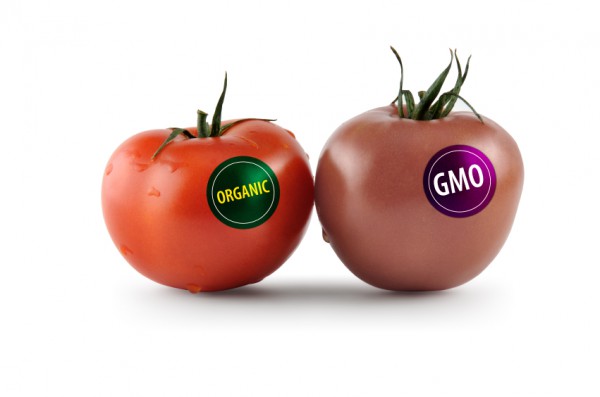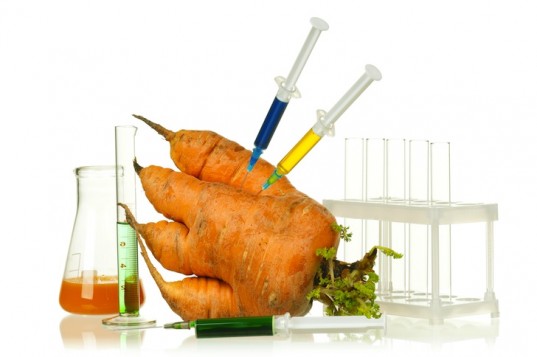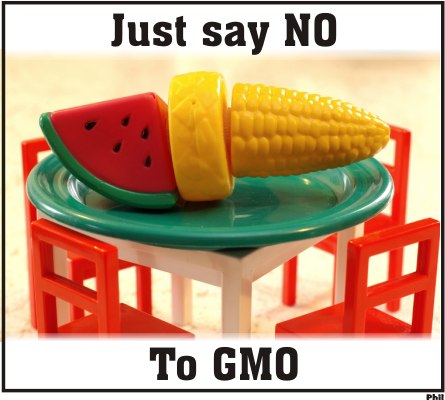Great eggs, untanning apples, salmon that grows quickly, pigs that are less harmful to the environment …
Twenty years ago certainly none of us thought that will be consuming food that grow in technical laboratories, not in nature.
According to some analyzes, more than 200 million hectares of arable land worldwide are used for the cultivation of genetically modified food (GMOs). The most popular GMO cereal is soybeans, followed by maize, cotton and oilseed rape.
Also in this list are included:papaya, potato, rice, tomatoes, courgettes etc..
The future of our diet with grains, fruits and meat, day by day is with more features of GMO.

What is genetically modified food?
-Genetically modified food is produced by inserting the genetic material (DNA) from one species to another, with the techniques of genetic engineering. This enabled the transfer of the desired characteristic from one to another species even if they are not in relation, or perhaps between animals and plant.
For example, a gene that acts like antifreeze taken from polar fish is inserted into tomatoes and strawberries to prevent freezing. In pig that is inserted gene from human, grow faster and more effectively.
What is genetic engineering?
-Genetic engineering (GI) is a new technology that allows manipulation of genes. Genetic engineering, also called genetic modification, is the direct manipulation of an organism’s genome using biotechnology. (Indirect genetic modification through artificial selection has been practiced for centuries.)
New DNA may be inserted in the host genome by first isolating and copying the genetic material of interest using molecular cloning methods to generate a DNA sequence, or by synthesizing the DNA, and then inserting this construct into the host organism. Genes may be removed, or “knocked out”, using a nuclease.
Gene targeting is a different technique that uses homologous recombination to change an endogenous gene, and can be used to delete a gene, remove exons, add a gene, or introduce point mutations.

Twenty years ago certainly none of us thought that will be consuming food that grow in technical laboratories, not in nature.
According to some analyzes, more than 200 million hectares of arable land worldwide are used for the cultivation of genetically modified food (GMOs). The most popular GMO cereal is soybeans, followed by maize, cotton and oilseed rape.
Also in this list are included:papaya, potato, rice, tomatoes, courgettes etc..
The future of our diet with grains, fruits and meat, day by day is with more features of GMO.

What is genetically modified food?
-Genetically modified food is produced by inserting the genetic material (DNA) from one species to another, with the techniques of genetic engineering. This enabled the transfer of the desired characteristic from one to another species even if they are not in relation, or perhaps between animals and plant.
For example, a gene that acts like antifreeze taken from polar fish is inserted into tomatoes and strawberries to prevent freezing. In pig that is inserted gene from human, grow faster and more effectively.
What is genetic engineering?
-Genetic engineering (GI) is a new technology that allows manipulation of genes. Genetic engineering, also called genetic modification, is the direct manipulation of an organism’s genome using biotechnology. (Indirect genetic modification through artificial selection has been practiced for centuries.)
New DNA may be inserted in the host genome by first isolating and copying the genetic material of interest using molecular cloning methods to generate a DNA sequence, or by synthesizing the DNA, and then inserting this construct into the host organism. Genes may be removed, or “knocked out”, using a nuclease.
Gene targeting is a different technique that uses homologous recombination to change an endogenous gene, and can be used to delete a gene, remove exons, add a gene, or introduce point mutations.

What are genetically modified organisms?
- Plants, animals or micro organisms that have changed through genetic engineering are termed genetically modified organisms or GMOs. Bacteria were the first organisms to be genetically modified.
-They disrupt the biodiversity in nature, because GM crops interact with the natural flora and fauna. They multiply, mutate, invade the surrounding wildlife and destroy. GM plants cause sterility of the soil and the inability to grow organic food.
- GMO destroys the wildlife. They made the plants resistant of insects, releasing toxins in the soil, thus destroy bees, butterflies and other insects that normally dependent on natural flowers.
- More than two-thirds of GM plants produced so far are declared as ruthless killers because of the herbicide effect on the conventional and organic crops.

Is there a risk to your health?
- With consumption of GM food, there is a possibility of allergic reactions of your body, which are often treated as allergies with unclear origin;
- Possible resistance to antibiotics. In recent years health professionals have become alarmed by the increasing number of bacterial strains that are showing resistance to antibiotics. There is concern that bacteria living in the guts of humans and animals could pick up an antibiotic resistance gene from a GM plant before the DNA becomes completely digested.
- GM food can have a toxic effect. This could happen through the process of inserting the gene into the plant.
- Decreased Nutritional Value
A genetically modified plant could theoretically have lower nutritional quality than its traditional counterpart by making nutrients unavailable or indigestible to humans.
Source: http://www.healthyfoodhouse.com/genetically-modified-food/#sthash.Aho4YXft.dpuf
Post a Comment